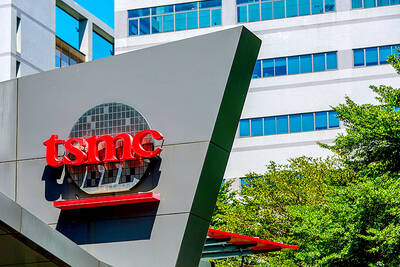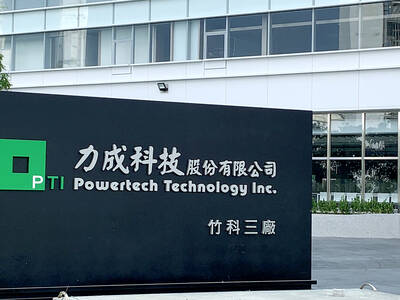Sercomm Corp (中磊) saw its shares rally 1.97 percent yesterday after the broadband equipment supplier gave an upbeat business outlook for next year, expecting robust demand for Internet-connected devices from 5G and Wi-Fi-related devices to fiber-optic products to drive revenue growth.
The Taipei-based company is one of only a few among local electronics firms that expects growth in the post-COVD-19 era, as Internet connection has become indispensable despite the world economy facing greater downside risks due to surging inflation and intensifying geopolitical tensions.
The stock price of Sercomm surged 1.97 percent to the highest level in more than one month at NT$82.7, outperforming the TAIEX, which edged lower 0.04 percent yesterday.

Photo: CNA
“We are looking at healthy and stable growth next year,” company president Ben Lin (林斌) told reporters on Thursday. “Although the overall market demand is in decline, we have developed the right products catering to customers’ demand from certain growing segments.”
The constant technology migration to higher-speed Internet connections through 5G and Wi-Fi-6 technology offers growth opportunities, Sercomm said.
The world’s major economies are injecting massive funds into infrastructure construction including fiber-optic networks to stimulate the economy, which would provide a boon to Sercomm, the company said.
Aside from existing product lines, Sercomm expects to see rapid growth in new demand for television set-top boxes from telecom operators. Sercomm generates about 80 percent of its revenue from supplying broadband devices to telecom operators around the world.
Sercomm has a long order visibility for the next 12 months, but the company is cautiously handling customers’ orders and building chip inventory, as mounting uncertainty about external factors — geopolitical conflict in particular — could cripple demand.
Telecom operators from the EU have axed orders since the second and third quarters, as the economic block has been severely hit by soaring inflation and high energy prices.
However, consistent growth from other areas such as India and Japan have helped offset the losses, Sercomm chairman James Wang (王煒) told reporters on Thursday.
To minimize any impact from geopolitical conflicts, Sercomm has diversified its manufacturing site to the Philippines and is developing a new manufacturing facility in India, the company said.
By next year, the Philippine factory capacity would surpass the company’s factory in China, Wang said.

RUN IT BACK: A succesful first project working with hyperscalers to design chips encouraged MediaTek to start a second project, aiming to hit stride in 2028 MediaTek Inc (聯發科), the world’s biggest smartphone chip supplier, yesterday said it is engaging a second hyperscaler to help design artificial intelligence (AI) accelerators used in data centers following a similar project expected to generate revenue streams soon. The first AI accelerator project is to bring in US$1 billion revenue next year and several billion US dollars more in 2027, MediaTek chief executive officer Rick Tsai (蔡力行) told a virtual investor conference yesterday. The second AI accelerator project is expected to contribute to revenue beginning in 2028, Tsai said. MediaTek yesterday raised its revenue forecast for the global AI accelerator used

Taiwan Semiconductor Manufacturing Co (TSMC, 台積電) has secured three construction permits for its plan to build a state-of-the-art A14 wafer fab in Taichung, and is likely to start construction soon, the Central Taiwan Science Park Bureau said yesterday. Speaking with CNA, Wang Chun-chieh (王俊傑), deputy director general of the science park bureau, said the world’s largest contract chipmaker has received three construction permits — one to build a fab to roll out sophisticated chips, another to build a central utility plant to provide water and electricity for the facility and the other to build three office buildings. With the three permits, TSMC

The DBS Foundation yesterday announced the launch of two flagship programs, “Silver Motion” and “Happier Caregiver, Healthier Seniors,” in partnership with CCILU Ltd, Hondao Senior Citizens’ Welfare Foundation and the Garden of Hope Foundation to help Taiwan face the challenges of a rapidly aging population. The foundation said it would invest S$4.91 million (US$3.8 million) over three years to foster inclusion and resilience in an aging society. “Aging may bring challenges, but it also brings opportunities. With many Asian markets rapidly becoming super-aged, the DBS Foundation is working with a regional ecosystem of like-minded partners across the private, public and people sectors

BREAKTHROUGH TECH: Powertech expects its fan-out PLP system to become mainstream, saying it can offer three-times greater production throughput Chip packaging service provider Powertech Technology Inc (力成科技) plans to more than double its capital expenditures next year to more than NT$40 billion (US$1.31 billion) as demand for its new panel-level packaging (PLP) technology, primarily used in chips for artificial intelligence (AI) applications, has greatly exceeded what it can supply. A significant portion of the budget, about US$1 billion, would be earmarked for fan-out PLP technology, Powertech told investors yesterday. Its heavy investment in fan-out PLP technology over the past 10 years is expected to bear fruit in 2027 after the technology enters volume production, it said, adding that the tech would